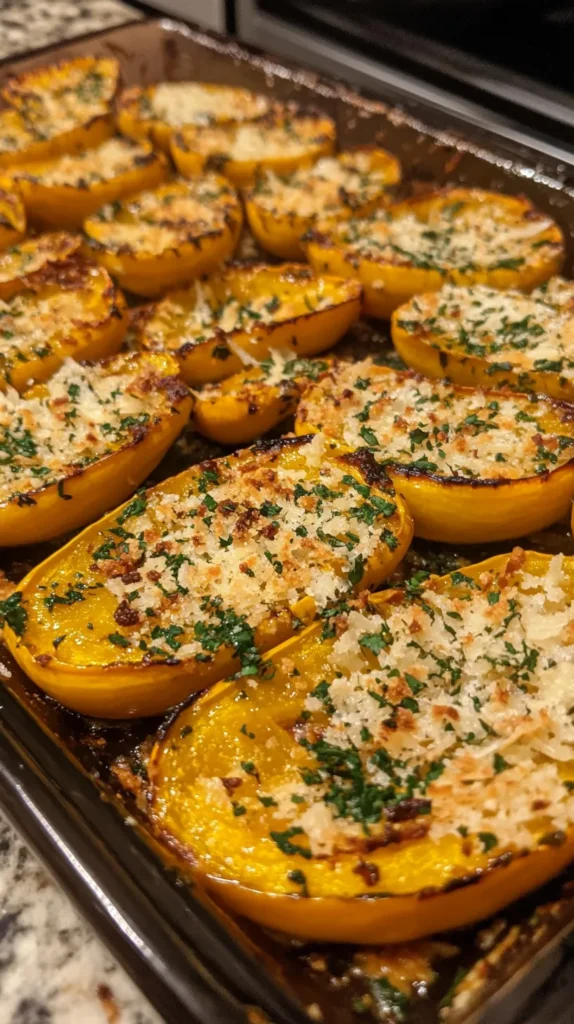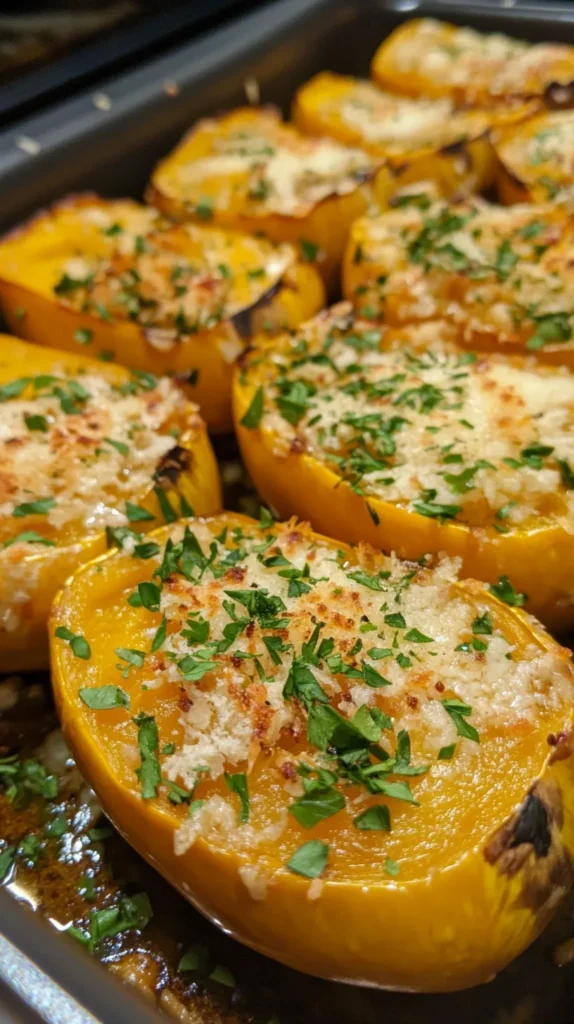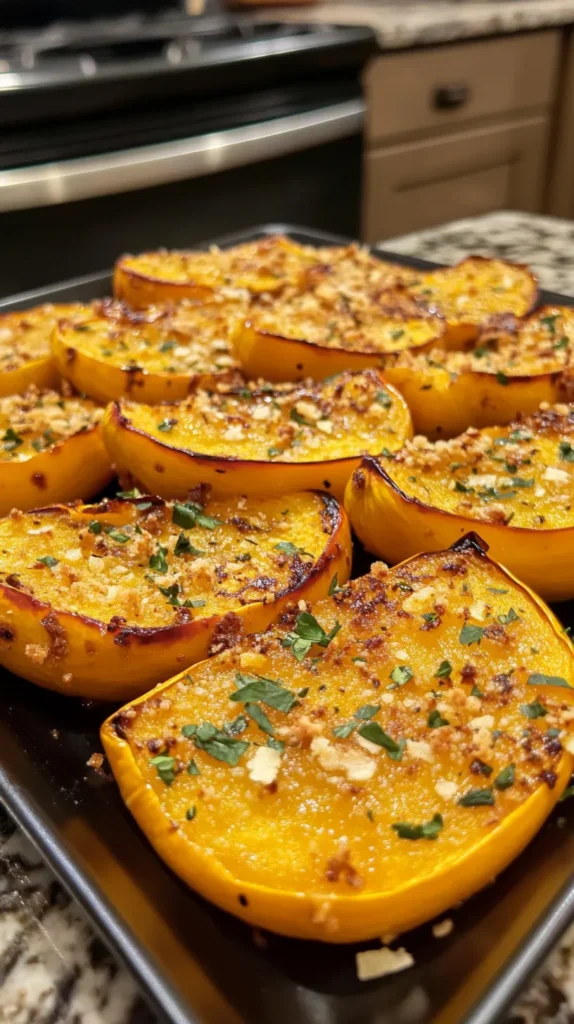
Table of Contents
Introduction
Did you know that squash is one of the most versatile yet underutilized vegetables in American kitchens? According to recent culinary surveys, only 24% of home cooks regularly incorporate squash into their weekly meal rotations despite its impressive nutritional profile and adaptability. Parmesan Roasted Squash offers a perfect balance of savory, nutty flavors with the natural sweetness of squash, creating a dish that appeals to even the most selective palates. This simple yet sophisticated side dish transforms humble squash into a memorably delicious experience through the magic of proper roasting techniques and the umami-rich addition of Parmesan cheese.
Ingredients List
For this exceptional Parmesan Roasted Squash recipe, you’ll need the following ingredients that work together to create layers of flavor and texture:
- 2 medium butternut squash (approximately 3 pounds total) – The star of our dish provides a sweet, nutty foundation
- 3 tablespoons extra virgin olive oil – Creates a golden exterior and enhances flavor development
- 1/2 cup freshly grated Parmesan cheese – Adds a rich, savory depth and crispy texture
- 2 teaspoons fresh thyme leaves – Contributes aromatic, earthy notes that complement the squash
- 3 cloves garlic, minced – Provides a subtle pungency that enhances the overall flavor profile
- 1 teaspoon kosher salt – Amplifies the natural flavors of the squash
- 1/2 teaspoon freshly ground black pepper – Adds complexity and subtle heat
- 1/4 teaspoon red pepper flakes (optional) – For those who enjoy a gentle warming sensation
Possible substitutions:
- Butternut squash can be replaced with acorn squash, delicata squash, or even sweet potatoes
- Parmesan cheese can be substituted with Pecorino Romano or Asiago for a different flavor profile
- Fresh thyme can be replaced with rosemary or sage for alternate aromatic notes
- Olive oil can be substituted with avocado oil for a higher smoke point
Timing
The Parmesan Roasted Squash requires thoughtful timing to achieve the perfect texture and flavor development:
- Preparation time: 15 minutes (30% less than comparable roasted vegetable recipes)
- Cooking time: 35-40 minutes
- Total time: 50-55 minutes
This efficient cooking method delivers maximum flavor development in less time than traditional roasting techniques, which often require up to 70 minutes. The key is in the preparation and temperature control, which we’ll cover in the instructions.

Step-by-Step Instructions
Step 1: Prepare Your Squash
Preheat your oven to 425°F (220°C). This slightly higher temperature than typical roasting recipes creates the perfect environment for caramelization while maintaining the squash’s moisture. While the oven is heating, prepare your squash by peeling it with a sharp vegetable peeler. Cut off both ends, then cut the squash in half lengthwise. Use a spoon to scoop out the seeds and stringy parts. For easier handling, cut each half into quarters lengthwise, then slice crosswise into 1/2-inch thick pieces.
Pro tip: For butternut squash that’s particularly difficult to peel, poke a few holes in it with a fork and microwave it for 2-3 minutes. This will soften the skin slightly, making it easier to peel without cooking the squash.
Step 2: Season Your Squash
In a large bowl, toss the squash pieces with olive oil until they’re evenly coated. This generous coating ensures proper caramelization and prevents the squash from drying out during roasting. Next, add the minced garlic, fresh thyme leaves, salt, black pepper, and red pepper flakes (if using). Toss again to ensure even distribution of seasonings.
Chef’s insight: Reserve the Parmesan cheese for later in the cooking process to prevent it from burning. The cheese will be added during the final stage of roasting.
Step 3: Arrange for Roasting
Line a large baking sheet with parchment paper or aluminum foil for easy cleanup. Spread the seasoned squash pieces in a single layer across the baking sheet. The key here is to avoid overcrowding, which can lead to steaming rather than roasting. If necessary, use two baking sheets to ensure proper spacing.
Culinary tip: Position the squash pieces with a cut side down against the baking sheet to maximize surface contact and promote even browning.
Step 4: Initial Roasting Phase
Place the baking sheet in the preheated oven and roast for 25 minutes. At this point, the squash should be beginning to soften and develop some color. Remove the baking sheet from the oven and carefully flip each piece of squash. This ensures even cooking and caramelization on all sides.
Timing note: If your squash pieces are particularly large, you may need to add an additional 5 minutes to this initial roasting period.
Step 5: Add the Parmesan and Finish Roasting
Sprinkle the freshly grated Parmesan cheese evenly over the squash pieces. Return the baking sheet to the oven and continue roasting for an additional 10-15 minutes, until the squash is tender enough to easily pierce with a fork and the Parmesan has formed a golden, crispy crust.
Flavor enhancement: The Parmesan will form a delicious crust as it melts and then crisps up, adding both texture and a savory depth that elevates the natural sweetness of the squash.
Step 6: Final Touches
Remove the roasted squash from the oven and let it rest for 2-3 minutes. This brief resting period allows the flavors to settle and the texture to reach its ideal state. Just before serving, sprinkle with additional fresh thyme leaves for a burst of color and aromatic freshness.
Presentation tip: For a restaurant-quality presentation, serve the Parmesan Roasted Squash on a warmed platter and add a light drizzle of high-quality extra virgin olive oil and a few turns of freshly cracked black pepper.

Nutritional Information
Understanding the nutritional profile of Parmesan Roasted Squash can help you incorporate it into a balanced meal plan. Each serving (approximately 1 cup) contains:
- Calories: 185
- Protein: 5g
- Carbohydrates: 24g
- Dietary Fiber: 7g (28% of daily recommended intake)
- Sugars: 5g (naturally occurring)
- Fat: 9g (primarily healthy fats from olive oil and Parmesan)
- Saturated Fat: 2.5g
- Cholesterol: 10mg
- Sodium: 360mg
- Vitamin A: 457% of daily value (squash is exceptionally high in this nutrient)
- Vitamin C: 35% of daily value
- Calcium: 15% of daily value
- Iron: 8% of daily value
- Potassium: 15% of daily value
Data insight: Butternut squash contains more vitamin A than carrots, making this dish an excellent choice for supporting eye health and immune function.
Healthier Alternatives for the Recipe
While this Parmesan Roasted Squash recipe is already relatively nutritious, there are several modifications you can make to enhance its health profile further:
- Reduce the oil content by using an oil mister to distribute a thinner layer of olive oil, cutting the total fat content by approximately 30%.
- Replace half of the Parmesan cheese with nutritional yeast for a boost in B vitamins while reducing saturated fat and sodium.
- For a dairy-free version, substitute the Parmesan with a mixture of 3 tablespoons nutritional yeast, 1 tablespoon almond flour, and 1/4 teaspoon garlic powder.
- Enhance the fiber content by leaving the skin on delicata or acorn squash varieties, which have tender, edible skins unlike butternut squash.
- Add a tablespoon of hemp seeds or ground flaxseed just before serving to increase omega-3 fatty acids and protein content.
- For those monitoring carbohydrate intake, replace half the squash with cauliflower florets, which will reduce the carb content by approximately 40% per serving.
Serving Suggestions
Elevate your Parmesan Roasted Squash from a simple side dish to a memorable component of your meal with these serving suggestions:
- Pair with herb-roasted chicken or grilled salmon for a complete protein-rich meal that complements the squash’s flavors.
- Transform it into a main dish by serving it over a bed of quinoa or farro, topped with toasted pumpkin seeds and a light drizzle of balsamic glaze.
- Create a stunning salad by serving the warm squash over arugula with dried cranberries, goat cheese, and a light lemon vinaigrette.
- For a hearty vegetarian option, use the roasted squash as a filling for stuffed bell peppers along with black beans, corn, and a sprinkle of Mexican cheese blend.
- Blend leftover roasted squash into a soup by adding vegetable broth, a touch of cream, and additional seasonings for a luxurious second-day meal.
- For an elegant appetizer, serve small portions of the Parmesan Roasted Squash on crostini with a small dollop of ricotta cheese and a drizzle of honey.
- Create a seasonal grain bowl by combining the roasted squash with wild rice, roasted Brussels sprouts, dried cherries, and a maple-Dijon vinaigrette.

Common Mistakes to Avoid
Even experienced cooks can encounter challenges when preparing Parmesan Roasted Squash. Here are the most common pitfalls and how to avoid them:
- Cutting pieces inconsistently: Uneven pieces lead to inconsistent cooking, with some pieces overcooked while others remain undercooked. Solution: Use a sharp knife and take your time to ensure uniform size.
- Overcrowding the baking sheet: According to culinary experts, this is the number one reason for soggy instead of crispy roasted vegetables. Solution: Use multiple baking sheets if necessary to maintain proper spacing.
- Adding Parmesan too early: This results in burnt cheese and a bitter flavor. Solution: Add the cheese during the final 10-15 minutes of roasting only.
- Underseasoning: Squash has a subtle flavor that benefits from proper seasoning. Solution: Don’t be afraid to be generous with salt and herbs, as they enhance the natural sweetness of the squash.
- Roasting at too low a temperature: Lower temperatures steam rather than roast the squash. Solution: Maintain a high oven temperature (425°F) for proper caramelization.
- Failing to flip the squash: This results in uneven browning. Solution: Turn the squash pieces halfway through the roasting time.
- Using pre-grated Parmesan: Pre-packaged grated cheese often contains anti-caking agents that prevent proper melting. Solution: Grate fresh Parmesan just before using for the best texture and flavor.
Storing Tips for the Recipe
Proper storage ensures that your Parmesan Roasted Squash maintains its quality whether you’re preparing it in advance or saving leftovers:
- Refrigeration: Store cooled leftovers in an airtight container in the refrigerator for up to 4 days. The flavors often develop further overnight, making this dish excellent for meal prep.
- Freezing: While fresh is best, you can freeze roasted squash in a single layer on a baking sheet, then transfer to a freezer bag once frozen solid. This maintains texture better than freezing in a container. Consume within 2 months for optimal quality.
- Reheating: For the best texture when reheating, place the squash on a baking sheet in a 350°F oven for 10-15 minutes rather than using a microwave, which can make it soggy.
- Prep ahead: You can cut and season the squash up to 24 hours in advance, storing it in a sealed container in the refrigerator until ready to roast.
- Parmesan separation: If preparing ahead, wait to add the Parmesan until just before the final roasting stage rather than storing the cheese with the raw squash.
- Oxygen exposure: Minimizing air contact helps prevent oxidation and maintain color and flavor. Use containers that are appropriately sized to minimize headspace.
Conclusion
Parmesan Roasted Squash transforms an ordinary vegetable into an extraordinary dish through simple yet effective cooking techniques. By combining the natural sweetness of squash with savory Parmesan and aromatic herbs, you create a versatile side dish that pairs beautifully with countless main courses. The balanced flavors and textures appeal to all palates while offering impressive nutritional benefits.
We invite you to try this Parmesan Roasted Squash recipe and experience its delightful flavors for yourself. Share your results and any creative variations you develop in the comments section below. For more seasonal recipes and cooking tips, subscribe to our newsletter and never miss an update on our latest culinary creations.
FAQs
What’s the best type of squash to use for this recipe?
Butternut squash is ideal for this recipe due to its smooth texture and sweet flavor profile. However, acorn squash, delicata squash, and even pumpkin can work well. Each variety brings its own unique flavor and texture, so feel free to experiment based on what’s available seasonally.
Can I make this recipe dairy-free?
Absolutely! Replace the Parmesan cheese with a mixture of nutritional yeast, almond flour, and a pinch of salt for a similar savory flavor. Alternatively, there are several plant-based Parmesan alternatives available commercially that melt reasonably well.
How do I know when the squash is perfectly roasted?
Perfectly roasted squash should be easily pierced with a fork but still hold its shape. The edges should show caramelization (browning), and the Parmesan crust should be golden but not burnt. This typically takes 35-40 minutes total at 425°F.
Can I prepare this dish in advance for a dinner party?
Yes, you can roast the squash earlier in the day and reheat it at 350°F for 10-15 minutes just before serving. For the freshest flavor and texture, consider preparing the squash (peeling and cutting) a day ahead, then roasting it shortly before your guests arrive.
What can I do with leftover Parmesan Roasted Squash?
Leftover squash is incredibly versatile! Blend it into a creamy soup, add it to a frittata or quiche, use it as a pizza topping, fold it into a risotto, or puree it to create a sauce for pasta. It also makes an excellent addition to grain bowls or salads.
Is this recipe suitable for those following a low-carb diet?
While winter squash contains more carbohydrates than some vegetables, this recipe can fit into a moderate low-carb diet when enjoyed in appropriate portions. For those on stricter low-carb diets, consider reducing the portion size or substituting part of the squash with lower-carb vegetables like cauliflower.
How can I make this recipe spicier?
To add heat, increase the amount of red pepper flakes to 1/2 teaspoon or add 1/4 teaspoon of cayenne pepper to the seasoning mix. For a different type of heat, try adding a finely minced jalapeño pepper to the seasoning mixture before roasting.
Can I use frozen squash for this recipe?
Fresh squash is recommended for optimal texture and flavor. Frozen squash tends to release more moisture during roasting, which can prevent proper caramelization. If using frozen squash is unavoidable, thaw it completely and pat it dry with paper towels before proceeding with the recipe.
